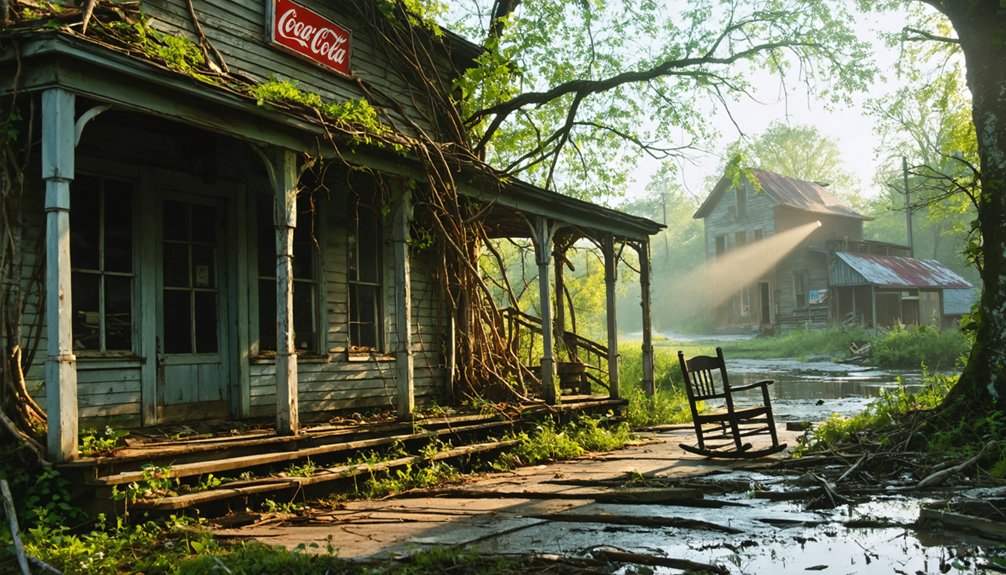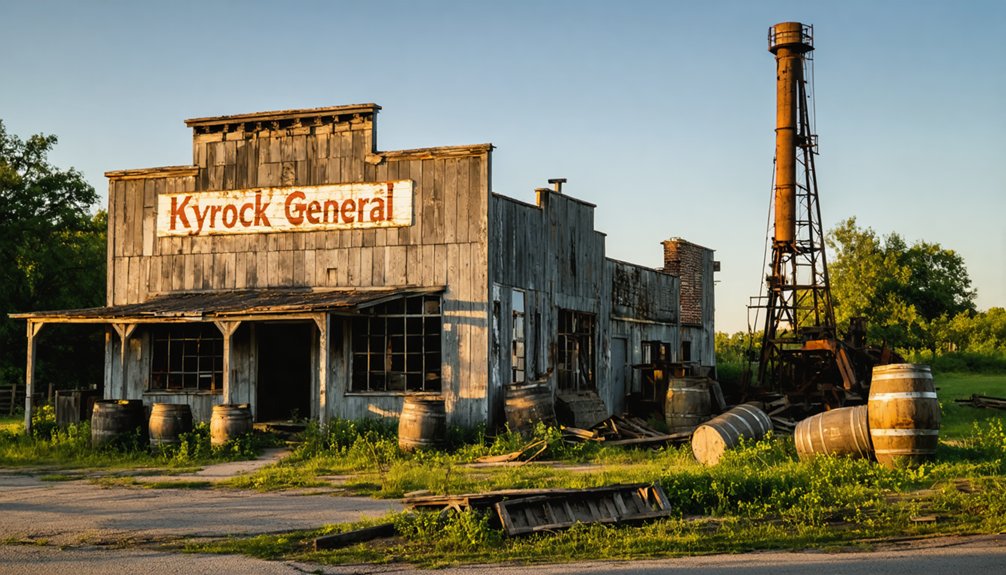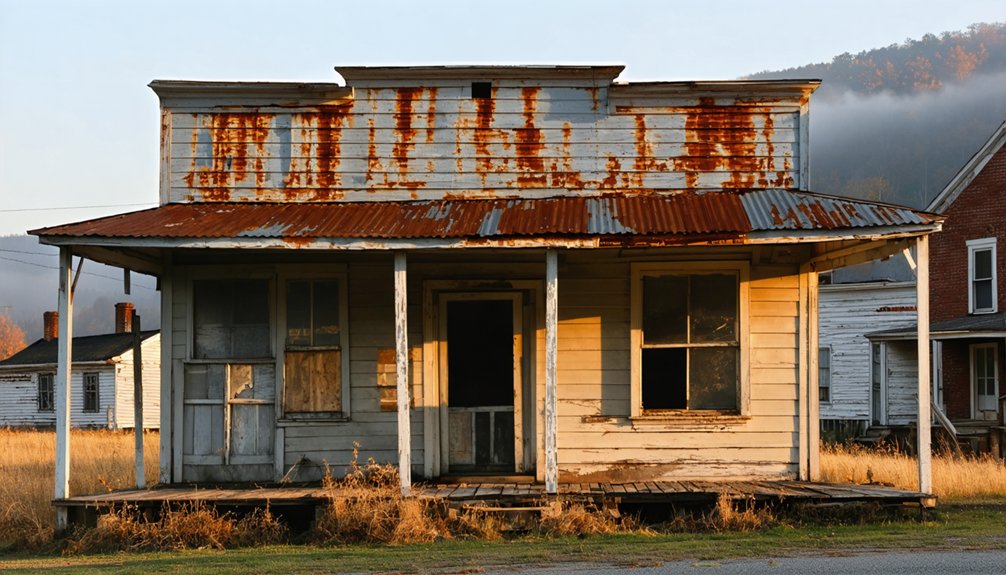You’ll discover Kyrock’s haunting ruins in Kentucky’s Edmonson County, where a bustling company town once dominated America’s rock asphalt industry. From 1917 to 1957, this self-contained community of 2,000 residents thrived with its own hospital, theater, schools, and church. Under Harry Carmichael’s leadership, families enjoyed stable employment through the Depression and both World Wars. Today, only a concrete water tower and crumbling foundations hint at deeper stories of this remarkable industrial heritage.
Key Takeaways
- Kyrock was a thriving company town established in 1917 by the Kentucky Rock Asphalt Company, housing over 2,000 residents.
- The town featured complete amenities including a post office, hospital, theater, church, and schools before its decline.
- Kyrock’s closure in 1957 led to mass displacement of workers, transforming it into a ghost town within a decade.
- Only concrete foundations and a water tower remain as physical evidence of the once-prosperous mining community.
- A state historical marker erected in 2014 preserves the memory of this abandoned Kentucky mining town.
The Rise of Kentucky’s Rock Asphalt Empire
While many Kentucky ghost towns faded into obscurity, Kyrock’s story began with the ambitious merger of two mining companies in 1917, giving birth to the Kentucky Rock Asphalt Company.
You’ll find the town’s industrial growth took off in 1918 when eight new quarries and a processing facility opened, transforming this corner of Edmonson County into a powerhouse of rock asphalt production.
Building on the foundation laid by the Wadsworth Stone and Pavement Company since 1900, Kyrock quickly became the region’s largest employer.
Following in Wadsworth’s pioneering footsteps, Kyrock rose to dominate local employment, transforming a rural community into an industrial hub.
The company’s reach extended far beyond Kentucky’s borders, with their unique paving material making its way to prestigious projects like the Indianapolis Motor Speedway and even across international waters to the streets of Rio de Janeiro and Havana.
The company achieved its peak production in 1927, processing an impressive 344,220 tons of rock asphalt with eight active operators.
Life in a Company-Built Community
As the Kentucky Rock Asphalt Company established Kyrock in 1918, they didn’t just build a workplace – they created a complete community.
You’d find everything you needed: a post office, hospital, theater, church, and schools. The Methodist church stood at the heart of community dynamics, where families gathered for worship and social events. Oral history interviews conducted in 1981 captured these memories of daily life.
You’d witness strong social traditions through the tight-knit relationships formed at community gatherings, school functions, and local celebrations.
While the United Mine Workers Local #72 represented your labor rights, the company provided essential services from housing to healthcare.
Your children would attend the local school, where education blended with mining town values.
Despite the demanding work in the mines and processing facilities, you’d experience the solidarity of a self-contained community where neighbors supported each other through challenges and celebrations. The company’s commitment to its workers remained strong as more than 2000 people relied on KYROCK for employment during major historical events.
Mining Operations and Industrial Heritage
When the Kentucky Rock Asphalt Company reached its peak in 1927, you’d see an impressive eight operators managing the production of 344,220 tons of rock asphalt.
The mining techniques they used were unique – quarrying bitumen-charged sandstone that didn’t need heating for application, making it a revolutionary product for road construction.
You’ll find the industrial innovations scattered across their 23,000-acre operation, from state-of-the-art processing plants to extensive rail systems.
Workers extracted valuable bituminous sandstone from the Early Pennsylvanian formations along the Nolin River, crushing and processing it for shipment.
The company’s technological prowess made them the world’s largest producer of natural rock asphalt, supporting critical infrastructure development through both World Wars and the Great Depression.
The Legacy of Harry Carmichael’s Leadership
You’ll find Harry Carmichael‘s lasting imprint on Kyrock in more than just the mining operations he oversaw from 1921 to 1949.
His vision transformed a rural mining site into a thriving company town complete with hotels, churches, schools, and modern amenities that supported over 2,000 workers and their families.
The community organized regular picnics and baseball to foster camaraderie among workers and their families.
Under his steady leadership through both world wars and the Great Depression, Carmichael built not just a mining empire but a close-knit community that became the world’s largest producer of natural rock asphalt.
Building a Mining Empire
Under Harry Carmichael’s visionary leadership from 1921 to 1949, the Kentucky Rock Asphalt Company transformed from a local mining venture into the world’s largest producer of natural rock asphalt.
You’ll find his innovative mining techniques revolutionized the industry, as KYROCK developed methods to extract and process bituminous sandstone without the need for heating or mixing – a game-changer for road construction nationwide.
The company’s success wasn’t just about mining; it was about building a thriving community.
Carmichael created a self-sufficient town where over 2,000 residents enjoyed modern amenities like electricity, running water, and essential services.
This community resilience proved crucial as KYROCK weathered the Great Depression and both world wars, maintaining stable employment when many other industries faltered.
Vision Beyond the Mine
Harry Carmichael’s legacy at KYROCK extended far beyond the mining operations that made the company famous.
You’ll find his imprint in every aspect of the thriving town he built – from the schools where children learned, to the hospital where families received care, to the theater where workers unwound after long days in the quarry.
His vision for social infrastructure transformed what could have been just another mining camp into a vibrant community.
You’d have seen more than 2,000 residents enjoying modern amenities like electricity and running water, while the company commissary, post office, and church fostered community cohesion.
Through the Great Depression and two world wars, Carmichael’s leadership kept KYROCK’s community stable, proving that investing in people’s well-being was as essential as extracting rock from the earth.
Daily Living Along Pigeon Creek

Life along Pigeon Creek in Kentucky revolved around the challenges and triumphs of a close-knit frontier community.
Pioneer lifestyles demanded resilience as families carved out their existence in the humid subtropical climate, clearing dense forests of oak and hickory to establish their homesteads. You’d find communal support was essential for survival, with neighbors helping neighbors through every obstacle. Many families established connections with workers at the nearby Johnson Mine Clay Pit, located just over 4 kilometers away. The abundance of passenger pigeons in the region provided an important food source for early settlers.
Your daily routine would’ve included:
- Working the land at 132 meters elevation, where the flat terrain made farming possible but required extensive forest clearing
- Gathering resources from Pigeon Creek’s life-sustaining waters
- Participating in shared tasks like barn-raising and crop harvesting with fellow settlers
These tight-knit bonds formed the backbone of the community, as you’d navigate the harsh frontier environment together, sharing traditions and creating a new way of life.
Economic Impact on Regional Development
Throughout its 40-year reign as Kentucky’s most successful asphalt mine, Kyrock transformed the regional economy into a thriving industrial hub.
Kyrock’s 40-year dominance over Kentucky’s asphalt industry reshaped a rural region into a powerhouse of commercial activity.
You’d have witnessed the company’s massive influence across 23,000 acres spanning multiple counties, where they built schools, hotels, neighborhoods, and even a baseball stadium. The operation directly supported 150 households and sparked the growth of supporting businesses in rail transport and equipment supply.
When petroleum-based asphalt emerged as a cheaper alternative, you’d have seen the harsh reality of limited economic diversification hit home.
The region’s reliance on a single industry left little room for regional resilience. As Kyrock closed in 1957, the economic ripples spread far beyond the mine itself, forcing surrounding communities to adapt or fade – a stark reminder of how deeply intertwined company and community had become.
The Final Days of a Thriving Town

You’d be hard-pressed to find a more dramatic end to a thriving Kentucky town than Kyrock’s final days in 1957, when the Kentucky Rock Asphalt Company’s closure forced 2,000 workers to seek jobs elsewhere.
As families packed up their homes and local businesses shuttered their doors one by one, the tight-knit community that had flourished for nearly four decades began to unravel. Abandoned railways that once connected the town to vital trade networks fell into disrepair.
Today, only a concrete water tower and crumbling foundations remain as silent witnesses to the once-prosperous company town.
Economic Activities End
By the late 1950s, Kyrock’s once-bustling streets fell eerily quiet as the Kentucky Rock Asphalt Company, the town’s economic heartbeat, succumbed to mounting pressures from petroleum-based competitors.
The economic decline hit the community hard, closing crucial pillars of local life:
- The post office shut its doors in 1955, ending 35 years of service.
- The asphalt plant ceased operations in 1957, leaving countless workers jobless.
- By 1966, the town officially lost its incorporation status.
Like many communities in Kentucky facing mechanization since 1940, the town struggled to maintain its workforce as technological changes transformed industrial operations.
Much like the devastating effects of the great fire of the 1930s that decimated Rocky Hill, Kyrock’s decline marked another Kentucky town’s fall from prosperity.
You’d hardly recognize the vibrant community that once shipped natural rock asphalt worldwide to places like Havana and Rio de Janeiro.
Despite the community’s resilience and attempts to adapt, the shift to cheaper, petroleum-based alternatives proved too powerful to overcome.
Today, only a lonely water tower and concrete footbridge foundation remain as silent witnesses to Kyrock’s golden age.
Community Scatters Forever
When the Kentucky Rock Asphalt Company closed its doors in 1957, families who’d built their lives in Kyrock faced heart-wrenching decisions.
You’d witness neighbors packing up their homes, seeking work in distant cities as the town’s economic foundation crumbled. The community fragmentation hit hard – houses emptied one by one, local gathering spots fell silent, and generations-old traditions began fading away.
The social displacement touched every aspect of life until Kyrock’s official disincorporation in 1966.
Today, you’ll find nature reclaiming the concrete footbridge foundations and abandoned structures, while the stories of this once-vibrant community live on through historical archives and the memories of former residents.
Though scattered across the country, these families carry with them the unbreakable bond of their shared Kyrock heritage.
Preserving Kyrock’s Historical Memory
As the physical remnants of Kyrock gradually fade into Kentucky’s landscape, dedicated preservationists and local historians work tirelessly to keep the town’s legacy alive through various initiatives.
Through historical storytelling and community engagement, they’re ensuring future generations won’t forget this once-thriving industrial powerhouse.
You’ll find several key preservation efforts in place:
- A state historical marker, dedicated in 2014, chronicles Kyrock’s significance and honors pioneers like George Carmichael.
- Digital archives and local heritage projects document the town’s rise and fall.
- Educational programs draw parallels with nearby ghost towns like Blue Heron.
While no large-scale museum exists at Kyrock today, local historical societies continue fighting to protect what remains.
They’re racing against time to capture stories from descendants and preserve documents before they’re lost forever.
Frequently Asked Questions
What Happened to the Residents After Kyrock Closed in 1957?
You’ll find that Kyrock’s residents scattered to surrounding towns seeking new jobs after 1957, leaving behind their memories of a once-thriving community where over 2,000 people had built their lives.
Are There Any Surviving Former Residents Who Still Live Nearby Today?
Like scattered leaves, former residents drifted to surrounding towns. While there’s no documented proof, you’ll find some of their descendants still rooted in nearby communities like Sweeden and Brownsville today.
What Specific Products Were Made From Kyrock’s Natural Rock Asphalt?
You’ll find the natural resources went mainly into road surfaces, skid-resistant paving materials, and speedway surfaces. The asphalt products didn’t need heating and were perfect for city streets and highways.
Did Any Other Industries Attempt to Establish Operations in Kyrock?
You won’t find evidence of any significant industrial attempts in Kyrock after the rock asphalt company closed. The economic impacts were lasting, and no new manufacturing or extraction industries took root there.
How Much Did Kyrock Workers Typically Earn During the Company’s Peak?
You’d have found worker wages at Kyrock ranging from $1 to $3 per day during the 1920s peak, with skilled workers earning more and payment often including company scrip for store purchases.
References
- https://kids.kiddle.co/List_of_ghost_towns_in_Kentucky
- https://www.youtube.com/watch?v=D9gOmfCuKLs
- https://www.onlyinyourstate.com/experiences/kentucky/12-ghost-towns-in-ky
- https://www.onlyinyourstate.com/experiences/kentucky/preserved-history-small-town-ky
- https://www.freakyfoottours.com/us/kentucky/
- https://history.ky.gov/markers/kyrock
- https://www.youtube.com/watch?v=ua6VZ_nsero
- https://www.wnky.com/throwback-thursday-the-ghost-town-of-kyrock-the-boomtown-that-once-was/
- https://en.wikipedia.org/wiki/Kyrock
- https://kgs.uky.edu/kgsweb/olops/pub/kgs/IC33_12.pdf



